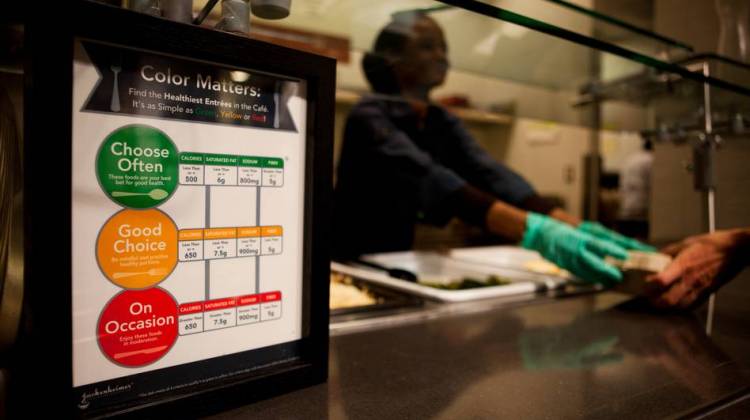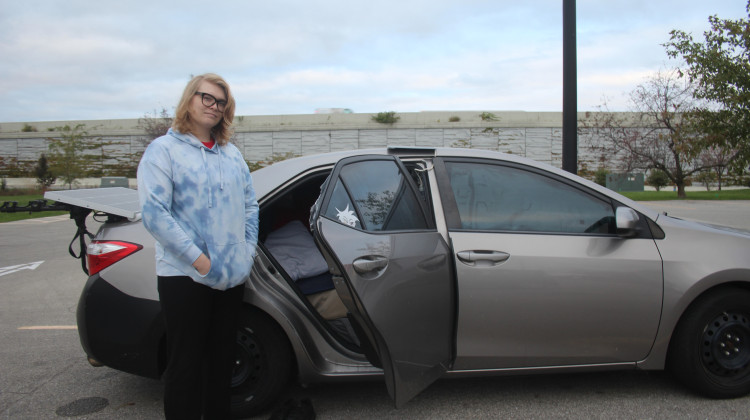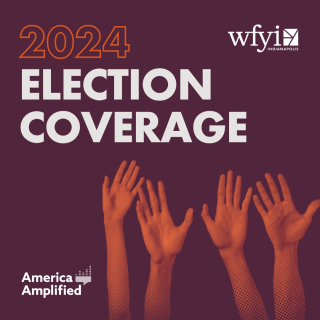Could a little red circle really make me bypass short ribs and mashed potatoes for some cod and rice instead? You've got to be kidding.
Well, a team of doctors at Massachusetts General Hospital sure think so — at least sometimes — and they have a study that backs them up.
It's research that hits close to home: Last April, when NPR moved into new headquarters, we got a snazzy new cafeteria. And little colored circles started popping up on menus.
Green circles with the words "Choose Often" appeared next to healthful, low-fat dishes. Yellow tags got placed next to the not-so-bad-for-you entrees, like baked cod and rice. And comfort foods packed with calories, fat and salt — yes, those short ribs and mashed potatoes — got branded with a bright red circle and a reminder to splurge only occasionally.
Sounds like a gimmick that could get me to pick the Brussels sprouts over the sweet potato fries for about week and then start to wear off, right? Not quite, says primary care physician Anne Thorndike.
She and her colleagues tried out a similar traffic-light label system in the cafeteria of their hospital, Massachusetts General, in Boston. The colorful cues not only helped hospital employees skip the sugary sodas, fattening pizzas and calorie-rich desserts at first, but the healthier eating lasted for the entire two years of the study, her team reports Tuesday in the American Journal of Preventive Medicine.
"These changes stuck with people," Thorndike tells The Salt. "Plus, the green, yellow and red system could be applied in many places," she says — like grocery stores, restaurants and even your own kitchen.
In addition to using the traffic-light labels, Thorndike and her team also rearranged the snacks and beverages in the cafeteria so that the most healthful options were in the front and at eye level.
This second strategy is called "choice architecture," Thorndike says. "We wanted to make the green choices the easiest option, the default choice," she says. "We added salads next to the pizzas and scattered water bottles all around the cafeteria." (As we've previously reported, these kinds of layout changes have also proven useful in nudging kids toward better choices in the school cafeteria.)
After six months, people started changing their eating habits, the researchers found. The number of red, unhealthy items purchased in the cafeteria dropped by 20 percent, while green purchases rose by 12 percent. But the biggest change occurred when it came to drink choices: Consumption of sugary sodas dropped by nearly 40 percent.
Could these changes really help people lose weight or improve their health?
"I don't want to over-claim that this is a weight-loss program," Thorndike says. "But if there is an employee that was buying a 20-ounce Coke, three times a week and/or every day, and they reduce their calories by 200 a day because of the traffic-light labels, then you could argue that it's helping that person lose weight. It has the potential."
For Thorndike, though, the tagging system is more about changing the culture around eating. "It's more about preventing weight gain," she says. "This should be our new normal. Cafeterias should be highlighting what's healthy."
Plus, she says, you can easily implement the red, yellow and green system in your kitchen at home.
Just fill one drawer with healthful snacks and then label it green. "Kids can eat whatever they want from that drawer," she says. Fill another drawer with less healthful snacks and label it red. "Kids have to ask permission to take from this drawer, or they get one of these snacks just on occasion," Thorndike says.
"It's a great concept for children, because they love it when they have a choice," she says. "We all do better when we have choice. When you tell people you can't have something, they go against it."
And don't forget choice architecture: Make fruit, vegetables and whole grains front, center and easy to find in the kitchen, Thorndike says. And put those red snacks up high and in the back of shelves.
"If you put the cookies up on the top shelf," she says, "they're out of sight, out of mind. By the time you climb up and reach them, you may have decided you really don't want that cookie in the first place. It's all about mindful choices."
9(MDEwMDc1MzM3MDEzNDczOTA0MDc1MzViMQ001))
 DONATE
DONATE











 Support WFYI. We can't do it without you.
Support WFYI. We can't do it without you.